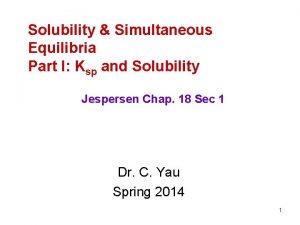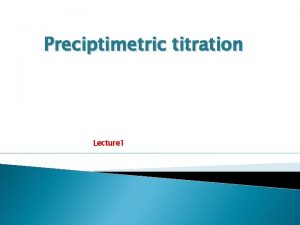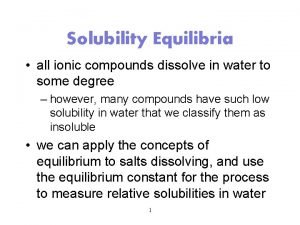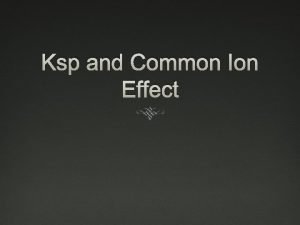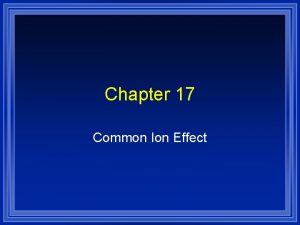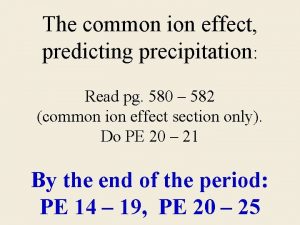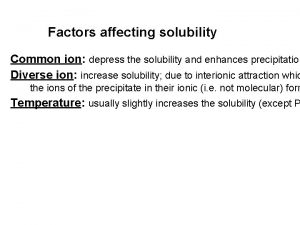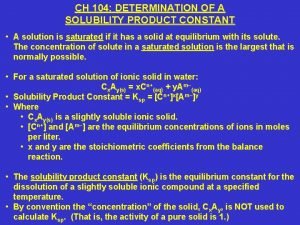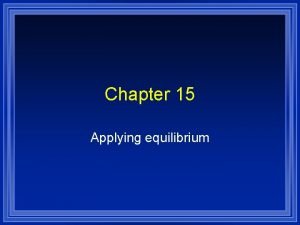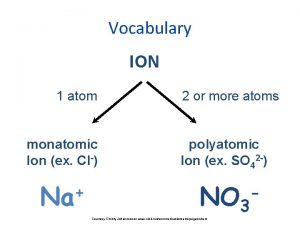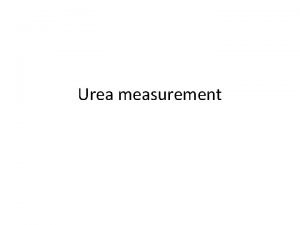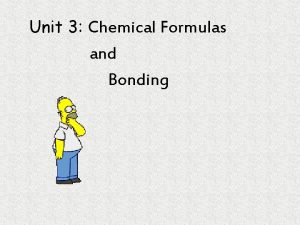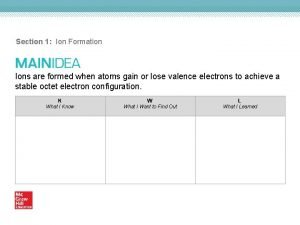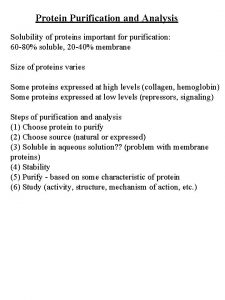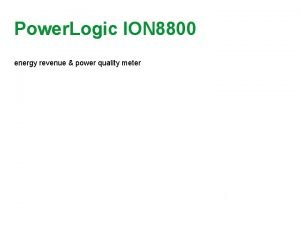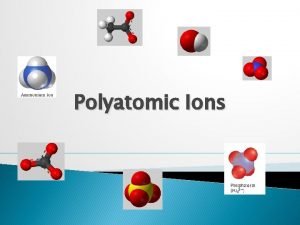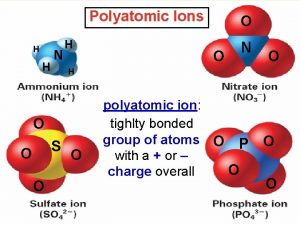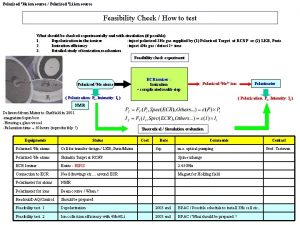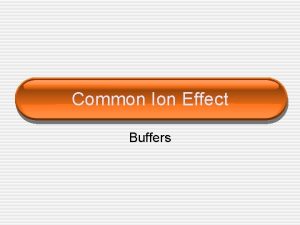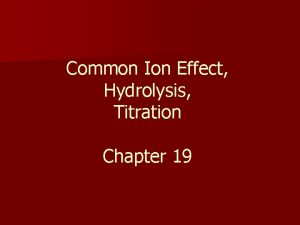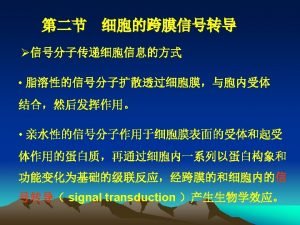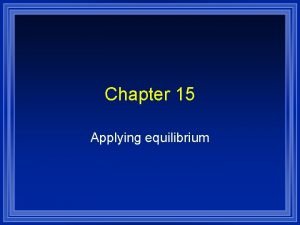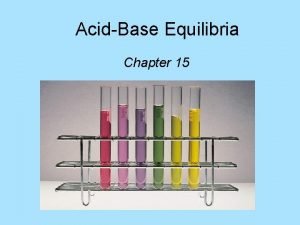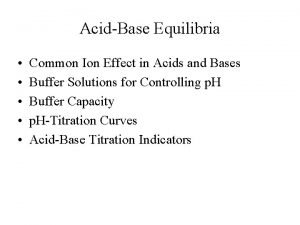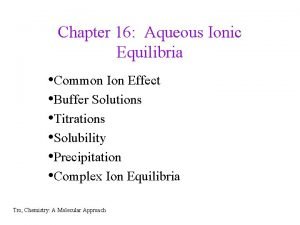Common Ion Effect Common Ion Effect An application



























































- Slides: 59

Common Ion Effect

Common Ion Effect An application of Le Châtelier’s principle. Shift in the equilibrium position due to the addition of an ion already involved in the equilibrium process.

A Common Ion Effect Consider the following equilibrium: HC 2 H 3 O 2(aq) + H 2 O(l) ⇌ H 3 O+(aq) + C 2 H 3 O 2 -(aq) What will happen if you add Na. C 2 H 3 O 2 to the solution? The solution will shift the equilibrium to the left because [C 2 H 3 O 2 -] increases; C 2 H 3 O 2 - is part of the equilibrium system. This equilibrium shift causes [H 3 O+] to decrease and raise the p. H of the solution. Solutions containing a mixture of HC 2 H 3 O 2 and Na. C 2 H 3 O 2 are less acidic than those solutions of HC 2 H 3 O 2 alone, and they are less basic than those of Na. C 2 H 3 O 2 alone.

p. H of weak acid and the Effect of Common Calculate the p. H of 1. 00 M HC 2 H 3 O 2 solution. Solution-1: Equilibrium: HC 2 H 3 O 2(aq) ⇌ H+(aq) + C 2 H 3 O 2 -(aq) Initial [ ], M 1. 00 0. 00 Change, D[ ], M -x +x +x Equilm. [ ], M (1. 00 – x) x x

p. H of Acetic Acid by itself. Solution-1: By approximation, x = [H 3 O+] = x = 4. 2 x 10 -3 M, p. H = 2. 37

Acetic Acid-Acetate Equilibrium with Common Ion What is the p. H of a solution that contains 1. 00 M HC 2 H 3 O 2 and 0. 50 M Na. C 2 H 3 O 2. Solution-2: Equilibrium: HC 2 H 3 O 2(aq) ⇌ H+(aq) + C 2 H 3 O 2 -(aq) Initial [ ], M 1. 00 0. 50 Change, D[ ], M -x +x +x Equilm. [ ], M (1. 00 – x) x (0. 50 + x)

p. H of Acetic Acid + Sodium Acetate Solution-2: By approximation, x = (1. 00/0. 50)(1. 8 x 10 -5) = 3. 6 x 10 -6 M [H+] = x = 3. 6 x 10 -6 M, p. H = 4. 44 Solution containing HC 2 H 3 O 2 and Na. C 2 H 3 O 2 is less acidic than one containing only HC 2 H 3 O 2 at the same concentration.

Characteristics of Buffer Solutions Contain weak acids or weak bases and their corresponding conjugate partners (common ions). Resist changes in p. H. Buffering capacity depends on concentrations of weak acid or weak base and their common ions. Effective p. H buffering range ~ p. Ka 1

Characteristics of Buffer Solutions 1. 2. 3. 4. Buffers contain relatively large amounts of the weak acids (HA) and their conjugate base (A )־ , (or weak bases and their conjugate acids) Buffer p. H is determined by the p. Ka of the acid HA and the molar ratio of the conjugate base to acid: [A ]־ /[HA]. Buffer p. H changes very little because the ratio [A ]־ /[HA] changes very little when a small amount of strong acid or strong base is added. [H 3 O+] in buffer solutions remains more or less constant: Most of H+ from strong acid is absorbed by the conjugate base A ; ־ most of OH ־ added from strong base reacts with acid HA in the buffer to yield A ־ and H 2 O.

Solving Problems with Buffered Solutions

Buffering: How Does It Work?

Buffering: How Does It Work?

Buffer Solutions

Henderson–Hasselbalch Equation • HA(aq) ⇌ H+(aq) + A-(aq); • Ka = • p. H = p. Ka + log([A–]/[HA]) • For a particular buffer system, solutions with the same [A–]/[HA] ratio have same p. H.

p. H of Buffer Solution: example #1 What is the p. H of a buffer solution that is 0. 45 M acetic acid (HC 2 H 3 O 2) and 0. 85 M sodium acetate (Na. C 2 H 3 O 2)? The Ka for acetic acid is 1. 8 × 10– 5. Solution: p. H = p. Ka + log([C 2 H 3 O 2 -]/[HC 2 H 3 O 2] p. H = -log(1. 8 × 10– 5) + log(0. 85/0. 45) p. H = 4. 74 + 0. 28 = 5. 02

Buffering Capacity How much H 3 O+ or OH- the buffer can absorb without significantly changing its p. H depends on the concentrations of HA and A ־. High [HA] and [A ]־ lead to large buffering capacity. Optimal buffering occurs when [HA] = [A ; ]־ Ratio [A–] / [HA] ~ 1 strong resist to change when either H 3 O+ or OH– is added.

Some Common Buffers p. Ka p. H Range • HCHO 2 – Na. CHO 2 3. 74 2. 74 – 4. 74 • CH 3 CO 2 H – Na. CH 3 CO 2 4. 74 3. 74 – 5. 74 • KH 2 PO 4 – K 2 HPO 4 7. 21 6. 20 – 8. 20 • CO 2/H 2 O – Na. HCO 3 6. 37 5. 40 – 7. 40 • NH 4 Cl – NH 3 9. 25 8. 25 – 10. 25

Choosing a Buffer System • The weak acid in buffer has p. Ka close to target p. H. • For example, KH 2 PO 4 and K 2 HPO 4 may be used to buffer at p. H ~ 7. 5 (H 2 PO 4 ־ has p. Ka = 7. 20) • Phosphate buffer is most effective in the p. H range 6. 20 – 8. 20; it has the highest buffering capacity at about p. H = 7. 20.

Making Buffer Solution: example #2 A phosphate buffer with p. H = 7. 40 is prepared using KH 2 PO 4 and K 2 HPO 4. (a) What is the molar ratio of [HPO 42 -] to [H 2 PO 4 -] in the buffered solution? (b) If [H 2 PO 4 -] = 0. 20 M, what is [HPO 42 -]? (c) How many grams of KH 2 PO 4 and K 2 HPO 4, respectively, are needed to make 500. m. L of this solution? (H 2 PO 4 - has Ka = 6. 2 x 10 -8)

Solutions to Buffer example #2 (a) Use Henderson-Hasselbalch equation: • p. H = p. Ka + log([HPO 42 -]/[H 2 PO 4 -]) • 7. 40 = 7. 21 + log([HPO 42 -]/[H 2 PO 4 -]) • log([HPO 42 -]/[H 2 PO 4 -]) = 7. 40 – 7. 21 = 0. 19 • [HPO 42 -]/[H 2 PO 4 -] = 100. 19 = 1. 55 (b) If [H 2 PO 4 -] = 0. 20 M, • [HPO 42 -] = 1. 55 x 0. 20 M = 0. 31 M

Solutions to Buffer example #2 (c) Moles of KH 2 PO 4 needed = 500. m. L x (1 L/1000 m. L) x 0. 20 mol/L = 0. 10 mole • Moles of K 2 HPO 4 needed = 500. m. L x (1 L/1000 m. L) x 0. 31 mol/L = 0. 155 mole • Grams of KH 2 PO 4 needed = 0. 10 mol x (136. 086 g/mol) = 14 g • Grams of K 2 HPO 4 needed = 0. 155 mol x (174. 178 g/mol) = 27 g

Buffer Exercise #1 Indicate whether each of the following mixtures makes a buffer solution. Explain. (a) 50. 0 m. L of 0. 20 M CH 3 CO 2 H + 50. 0 m. L of 0. 20 M Na. CH 3 CO 2; (b) 50. 0 m. L of 0. 20 M HC 2 H 3 O 2 + 50. 0 m. L of 0. 10 M Na. OH; (c) 50. 0 m. L of 0. 20 M HC 2 H 3 O 2 + 50. 0 m. L of 0. 20 M Na. OH; (d) 50. 0 m. L of 0. 20 M Na. C 2 H 3 O 2 + 50. 0 m. L of 0. 20 M HCl; (e) 50. 0 m. L of 0. 20 M Na. C 2 H 3 O 2 + 50. 0 m. L of 0. 10 M HCl (Answer: (a) Yes; (b) Yes; (c) No; (d) No; (e) Yes)

Buffer Exercise #2 Indicate whether each of the following solution mixtures will make a buffer solution. Explain. (a) 50. 0 m. L of 0. 10 M NH 3 + 50. 0 m. L of 0. 10 M NH 4 NO 3; (b) 50. 0 m. L of 0. 10 M NH 3 + 50. 0 m. L of 0. 10 M HNO 3; (c) 50. 0 m. L of 0. 10 M NH 3 + 25. 0 m. L of 0. 10 M HNO 3; (d) 50. 0 m. L of 0. 10 M NH 4 NO 3 + 25. 0 m. L of 0. 10 M Na. OH; (e) 50. 0 m. L of 0. 10 M NH 4 NO 3 + 50. 0 m. L of 0. 10 M Na. OH; (Answer: (a) Yes; (b) No; (c) Yes; (d) Yes; (e) No)

Buffer Exercise #3 An acetate buffer solution is prepared by mixing 35. 0 m. L of 1. 0 M acetic acid and 65. 0 m. L of 1. 0 M sodium acetate. (a) What is the p. H of this solution? (b) If 0. 010 mole of HCl is added to this solution without altering its volume, what will be the p. H of the resulting solution? (Ka = 1. 8 x 10 -5) (Answer: (a) p. H = 5. 01; (b) p. H = 4. 83 after adding 0. 10 M HCl)

Buffer Exercise #4 The Ka values of some acids and base are given below: 1. Acetic acid, CH 3 CO 2 H, Ka = 1. 8 x 10 -5; 2. Dihydrogen phosphate, H 2 PO 4 ־ , Ka = 6. 2 x 10 -8; 3. Ammonia, NH 3, Kb = 1. 8 x 10 -5; 4. Hydrogen carbonate, HCO 3 ־ , Kb = 2. 3 x 10 -8. What solutions are used to make buffers with the following p. H’s? (i) p. H = 7. 00; (ii) p. H = 4. 50; (iii) p. H = 9. 00 (iv) p. H = 9. 50; (v) p. H = 5. 00

Buffer Exercise #5 How many milliliters of each solution of 0. 50 M KH 2 PO 4 and 0. 50 M K 2 HPO 4 are needed to make 100. 0 m. L solution of phosphate buffer with p. H = 7. 50? What are the final concentrations of K+, H 2 PO 4 and HPO 42 -, in the buffer solution? (for H 2 PO 4 -, Ka = 6. 2 x 10 -8) (Answer: (a) 33. 9 m. L of KH 2 PO 4 + 66. 1 m. L of K 2 HPO 4; (b) [K+] = 0. 83 M; [H 2 PO 4 -] = 0. 17 M; [HPO 42 -] = 0. 33 M)

Titration and p. H Curves • Plotting the p. H of the solution being analyzed as a function of the amount of titrant added. • From p. H-titration curve determine the equivalence point – when enough titrant has been added to react exactly with the substance in solution being titrated.

The p. H Curve for the Titration of 50. 0 m. L of 0. 200 M HNO 3 with 0. 100 M Na. OH

The p. H Curve for the Titration of 100. 0 m. L of 0. 50 M Na. OH with 1. 0 M HCI

The p. H Curve for the Titration of 50. 0 m. L of 0. 100 M HC 2 H 3 O 2 with 0. 100 M Na. OH

The p. H Curves for the Titrations of 50. 0 -m. L Samples of 0. 10 M Acids with Various Ka Values with 0. 10 M Na. OH

The p. H Curve for the Titration of 100. 0 m. L of 0. 050 M NH 3 with 0. 10 M HCl

Acid-Base Indicators • An indicator is a substance added to acid or base solution to marks the end point of a titration by the change of its color. For example, phenolphthalein changes from colorless to pink at the end point when an acid is titrated with a base. • The end point of a titration should correspond to the equivalence points of the acid-base reaction.

The Acid and Base Forms of the Indicator Phenolphthalein

The Methyl Orange Indicator is Yellow in Basic Solution and Red in Acidic Solution

Choosing Indicators 1. The p. H range for color changes should occur within the sharp vertical rise (or drop) in the p. H-titration curves. 2. An indicator changes color at p. H = p. Ka ± 1, where p. Ka is that of the indicator used.

p. H Ranges for Indicators

Common Indicators Indicators: Acid Base p. H Range Type of Titration Color 1. Methyl orange Orange Yellow 3. 2 – 4. 5 strong acid-strong base strong acid-weak base 2. Bromocresol Yellow Blue 3. 8 – 5. 4 strong acid-strong base green strong acid-weak base 3. Methyl red Red Yellow 4. 5 – 6. 0 strong acid-strong base strong acid-weak base 4. Bromothymol Yellow Blue 6. 0 – 7. 6 strong acid-strong base blue 5. Phenol Red Orange Red 6. 8 – 8. 2 strong acid-strong base weak acid-strong base

Useful p. H Ranges for Several Common Indicators

Calculating the p. H of solution during titration Strong Acid-Strong Base Titration; 1. Net reaction: H 3 O+(aq) + OH-(aq) 2 H 2 O 2. Determine the limiting reactant and calculate the final concentration of H 3 O+ or OH- that is in excess. 3. Calculate p. H using concentration of excess H 3 O+ or OH-

Titration Problem: example #1 A 20. 0 m. L aliquot of 0. 100 M HCl is titrated with 0. 100 M Na. OH solution. What is the p. H of the resulting solution after 15. 0 m. L of Na. OH has been added? Reaction: H 3 O+(aq) [I]before rxn: 0. 057 M [C]from rxn: -0. 043 M [E]after rxn: 0. 014 M + OH-(aq) 2 H 2 O 0. 043 M -0. 043 M 0. 000 p. H = -log(0. 014) = 1. 85

p. H of Weak Acid-Strong Base Titrations Net reaction: HA(aq) + OH-(aq) H 2 O + A-(aq); 1. Assume the reaction with OH- goes to completion; 2. If OH- is the limiting reactant: (mol of HA)final = (mol of HA)initial – (mol of OH-); (mol of A-)final = (mol of OH-) 3. [HA]final = (mol of HA)final/Vfinal; 4. [A-]final = (mol A-)final/Vfinal 5. p. H = p. Ka + log([A-]f/[HA]f)

Titration Problem: example #2 Weak Acid-Strong Base Titration: • A 20. 0 m. L aliquot of 0. 100 M HNO 2 is titrated with 0. 100 M Na. OH. (a) What is the p. H of the solution before titration? (b) What is the p. H of the solution after 15. 0 m. L of Na. OH has been added? (c) What is the p. H of the solution at equivalent point (after 20. 0 m. L of 0. 100 M Na. OH is added)? (Ka of HNO 2 = 4. 0 x 10 -4)

Solution to Titration Problem: example #2 (a) Solving initial concentration of H 3 O+ by approximation method: p. H = -log(0. 0063) = 2. 20

Solution to Titration Problem: example #2 (b) Concentrations after 15. 0 m. L of Na. OH is added: Reaction: HNO 2(aq) + OH-(aq) NO 2 -(aq) + H 2 O [I]before rxn: 0. 057 M 0. 043 M 0. 000 [C]from rxn: -0. 043 M +0. 043 M [E]after rxn: 0. 014 M 0. 000 0. 043 M • p. H = p. Ka + log([NO 2 -]f/[HNO 2]f) • = -log(4. 0 x 10 -4) + log(0. 043/0. 014) • = 3. 40 + 0. 49 = 3. 89

Solution to Titration Problem: example #2 (c) Calculating p. H at equivalent point: Reaction: HNO 2(aq) + OH-(aq) NO 2 -(aq) + H 2 O [I]before rxn: 0. 050 M 0. 000 [C]from rxn: -0. 050 M +0. 050 M [E]after rxn: 0. 000 M 0. 000 0. 050 M • At equivalent point, [NO 2 -] = 0. 050 M • Kb for NO 2 - = Kw/Ka = (1. 0 x 10 -14)/(4. 0 x 10 -4) = 2. 5 x 10 -11

Solution to Titration Problem: example #2 (c) Calculating p. H at equivalent point (continue): • Set up the following equilibrium for the reaction of NO 2 - with water: • Reaction: NO 2 -(aq) + H 2 O ⇄ HNO 2 + OH-(aq); [I]before rxn: 0. 050 M [C]from rxn: -x [E]after rxn: (0. 050 – x) 0. 000 +x x

Solution to Titration Problem: example #2 (c) Calculating p. H at equivalent point (continue): Kb = x 2/(0. 050 – x) = 2. 5 x 10 -11 • x = [OH-], • Using approximation method, • p. OH = -log(1. 1 x 10 -11) = 5. 95 • p. H = 14. 00 – 5. 95 = 8. 05

p. H of Strong Acid-Weak Base Titrations Net reaction: B(aq) + H 3 O+(aq) BH+(aq) + H 2 O; 1. Assume the reaction with H 3 O+ goes to completion; 2. If H 3 O+ is the limiting reactant, at the end of the reaction, (mol B)final = (mol B)initial – (mol H 3 O+); 3. (mol BH+)final = (mol H 3 O+) 4. [B]final = (mol B)final/Vfinal; 5. [BH+]final = (mol BH+)final/Vfinal 6. p. H = p. Ka + log([B]f/[BH+]f; (p. Ka is for BH+)

Titration Problem: example #3 Strong Acid-Weak Base Titration: • A 20. 0 m. L aliquot of 0. 100 M NH 3 is titrated with 0. 100 M HCl. (a) What is the p. H of the solution before titration? (b) What is the p. H of the solution after 10. 0 m. L of HCl has been added? (c) What is the p. H of the solution at equivalent point (after 20. 0 m. L of 0. 100 M HCl is added)? (Kb of NH 3 = 1. 8 x 10 -5)

Solution to Titration Problem: example #3 (a) Solving initial concentration of OH- by approximation method: [H 3 O+] = Kw/[OH-] = (1. 0 x 10 -14)/(1. 3 x 10 -3) = 7. 5 x 10 -12 M p. H = -log(7. 5 x 10 -12 M) = 11. 13

Solution to Titration Problem: example #3 (b) Concentration after 10. 0 m. L of HCl is added: Reaction: NH 3(aq) + H 3 O+(aq) NH 4+(aq) + H 2 O [I]before rxn: 0. 067 M 0. 033 M 0. 000 [C]from rxn: -0. 033 M +0. 033 M [E]after rxn: 0. 034 M 0. 000 0. 033 M • p. H = p. Ka + log([NH 3]f/[NH 4+]f) • = -log(5. 6 x 10 -10) + log(0. 034/0. 033) • = 9. 25 + (0. 0) = 9. 25

Solution to Titration Problem: example #3 (c) Calculating p. H at equivalent point: Reaction: NH 3(aq) + H 3 O+(aq) NH 4+(aq) + H 2 O [I]before rxn: 0. 050 M 0. 000 [C]from rxn: -0. 050 M +0. 050 M [E]after rxn: 0. 000 M 0. 000 0. 050 M • At equivalent point, [NH 4+] = 0. 050 M • Ka for NH 4+ = Kw/Kb = (1. 0 x 10 -14)/(1. 8 x 10 -5) = 5. 6 x 10 -10

Solution to Titration Problem: example #3 (c) Calculating p. H at equivalent point (continue): • Set up the following equilibrium for the reaction of NO 2 - with water: • Reaction: NH 3(aq) + H 3 O+(aq) NH 4+(aq) + H 2 O [I]before rxn: 0. 050 M [C]from rxn: -x [E]after rxn: (0. 050 – x) 0. 000 +x x

Solution to Titration Problem: example #3 (c) Calculating p. H at equivalent point (continue): Ka = x 2/(0. 050 – x) = 5. 6 x 10 -10 • x = [H 3 O+], • Using approximation method, • p. H = -log(5. 3 x 10 -6 = 5. 28

Titration Exercise #1 25. 0 m. L of 0. 10 M HCl is titrated with 0. 10 M Na. OH solution. (a) What is the p. H of the acid before Na. OH solution is added? (b) What is the p. H after 15. 0 m. L of Na. OH solution is added? (c) What is the p. H of the solution after 25. 0 m. L of Na. OH is added? (Answer: (a) p. H = 1. 00; (b) p. H = 1. 60; (c) p. H = 7. 00)

Titration Exercise #2 25. 0 m. L of 0. 10 M acetic acid is titrated with 0. 10 M Na. OH solution. (a) What is the p. H of the acid solution before Na. OH is added? (b) What is the p. H after 15. 0 m. L of Na. OH solution is added? (c) What is the p. H after 25. 0 m. L of Na. OH is added? (Answer: (a) p. H = 2. 87; (b) p. H = 4. 92; p. H = 8. 72)

Titration Exercise #3 25. 0 m. L of 0. 10 M lactic acid, HC 3 H 5 O 3, is titrated with 0. 10 M Na. OH solution. After 15. 0 m. L of Na. OH is added, the solution has p. H = 4. 03. (a) Calculate the Ka of lactic acid. (b) What is the initial p. H of 0. 10 M lactic acid before Na. OH is added? (Answer: (a) Ka = 1. 4 x 10 -4; (b) p. H = 2. 43)

 Common ion effect example
Common ion effect example Common ion effect example
Common ion effect example Solubility from ksp
Solubility from ksp Common ion effect explained
Common ion effect explained Applications of common ion effect
Applications of common ion effect Ice table example
Ice table example Solubility product and common ion effect
Solubility product and common ion effect Common ion effect example
Common ion effect example Common ion effect on solubility
Common ion effect on solubility Solubility vs solubility product
Solubility vs solubility product Ksp common ion effect
Ksp common ion effect Reaction quotient vs equilibrium constant
Reaction quotient vs equilibrium constant Common ion effect practice problems
Common ion effect practice problems Common ion effect
Common ion effect Ksp crane
Ksp crane C6h12 fuerza intermolecular
C6h12 fuerza intermolecular Dipolo dipolo inducido
Dipolo dipolo inducido Uniones intramoleculares
Uniones intramoleculares Intermolecular forces vapor pressure
Intermolecular forces vapor pressure Nh3ag
Nh3ag Define solubility product constant
Define solubility product constant Hac kps
Hac kps What is the use of text in multimedia
What is the use of text in multimedia Common gateway interface tutorial
Common gateway interface tutorial Programs that organize analyze and graph numerical data
Programs that organize analyze and graph numerical data Texas common application
Texas common application Texas common app
Texas common app Common application essay prompts 2018
Common application essay prompts 2018 Goarmyed common application
Goarmyed common application Bohr's effect in respiration
Bohr's effect in respiration Bottleneck effect
Bottleneck effect Income effect formula
Income effect formula Lowest common denominator and greatest common factor
Lowest common denominator and greatest common factor Common anode and common cathode
Common anode and common cathode Factors of 72
Factors of 72 Highest common factors and lowest common multiples
Highest common factors and lowest common multiples The gcf of 12 and 18
The gcf of 12 and 18 Multiples of 9 and 21
Multiples of 9 and 21 What is a monatomic ion
What is a monatomic ion Significance of urea
Significance of urea Is paradichlorobenzene ionic or covalent
Is paradichlorobenzene ionic or covalent Polyatomic ion
Polyatomic ion Tin iv sulfate formula
Tin iv sulfate formula Carbon dioxide ion
Carbon dioxide ion Tcs ion industry honour certification
Tcs ion industry honour certification Sputter ion pump working principle
Sputter ion pump working principle Spectator ions equation example
Spectator ions equation example How is positive ion formed
How is positive ion formed Zeroth order kinetics
Zeroth order kinetics What is ion trapping in pharmacology
What is ion trapping in pharmacology Suvning ion ko'paytmasi
Suvning ion ko'paytmasi Protein chromatography
Protein chromatography Ion medical term suffix
Ion medical term suffix Logicion
Logicion Potential of the glass electrode is given by
Potential of the glass electrode is given by Monatomic ion definition chemistry
Monatomic ion definition chemistry How to write polyatomic ions
How to write polyatomic ions Ion chart
Ion chart Polyatomic cation
Polyatomic cation An ion source is producing 6li ions
An ion source is producing 6li ions

